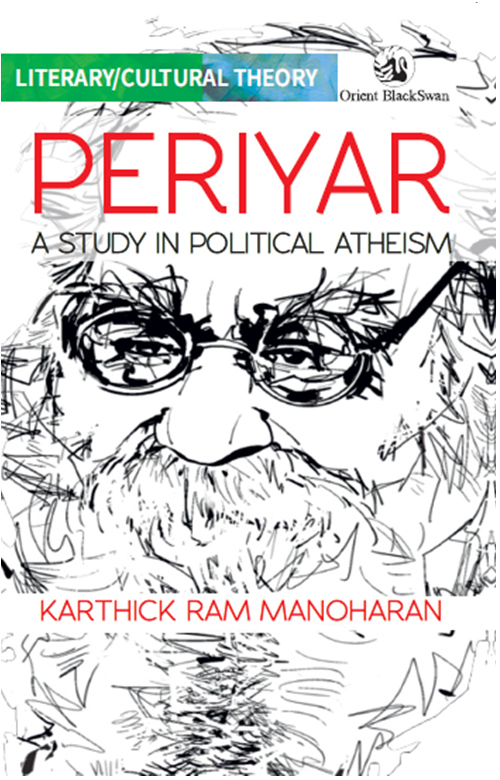
Karthick Ram Manoharan’s book Periyar: A Study in Political Atheism (published by Orient BlackSwan) in 2022 is a remarkable attempt to systematically and theoretically organise the complex ideas of Periyar with regard to religion. Periyar, a ‘practical person’, ‘strategist’, ‘thinker’, and ‘anti-philosopher,’ engaged with religion in multiple ways, making the task of presenting his ideas a challenging one. However, Manoharan executes this task skillfully, producing a highly readable text that makes the knowledge accessible to anyone interested, not just those in academia.
Manoharan weaves an analytic account of political atheism through the five chapters, providing a historical, political, and intellectual context for the arguments presented. The book begins by thoroughly, yet briefly, introducing Periyar to someone who may be reading about Periyar or Dravidian scholarship for the first time. The introduction covers the making of “Periyar” focusing on his relation to religion until his return from the Soviet Union in 1932. Manoharan maps Periyar’s personal life, the origin of his politics, the context of non-brahmin Dravidian politics, the historical-intellectual background that shapes Periyar, and his engagement with political movements of the times, providing readers with an understanding of the political-intellectual sketch of the region. Manoharan reads Periyar as an anti-philosopher who can be read philosophically, a non-theoretician from whose thoughts theory can emerge. The author draws a theoretical concept from Periyar’s work on religion, which is that of political atheism (p31). This concept is carefully elaborated in the subsequent chapters, where Manoharan delves deeper into Periyar’s views on religion.
Manoharan establishes the core arguments of Periyar’s political atheism as closer to the anarchist critique of religion of Mikhail Bukunin than the Marxist critique of religion. According to Manoharan, Periyar’s anti-Brahmanism was not just a rejection of religion but was a “political atheism that sought to critique, demystify, and dismantle the political theology of Brahmanism.” This critical opposition was against social, political, economic, moral, and philosophical systems that mystified the oppressive conditions in which humanity existed (p 54). The comparison between the anarchist tradition and Periyarism brings a different perspective to the scholarship in Dravidian studies that have previously produced extensive works on the closeness of Periyarism and Marxism. Manoharan also notes that Periyar was not explicitly anti-statist. One wonders what the philosophical and political implications of bringing Periyar closer to Bakunin would be, particularly in contemporary times.
In the book, Manoharan delves deeper into Periyar’s “anti-theological theology” by examining his interpretation of the Ramayana. Periyar’s interpretation portrays Ravana, the asura king, as a Dravidian revolutionary opposing the Brahminical Aryan figure, Rama. Manoharan argues that Periyar’s reading of the text was rooted in his anti-hegemonic politics and his opposition to the collusion of religion and the state (p 73). This critical stance towards religious texts, especially subversive readings of texts like the Ramayana, remains a crucial factor in Periyar’s enduring reputation as a towering figure beyond any possible appropriation by the Hindu right. Manoharan makes it clear at more than one place in the book that his purpose is a dialectical enquiry wherein the multiple positions on religions of the strategist that Periyar was could be made sense of. This becomes evident in his discussion of Periyar’s conversations about conversions to Islam and Buddhism. The book provides an elaborate discussion of the historical and political context of Periyar’s engagement with religious conversion, and how the essence of Periyar’s journey remained that of political atheism.
Throughout the book, there is a dialogue between history and the present, which makes Manoharan’s project of mapping Periyar’s political atheism both compelling and engaging. It is a valuable resource for scholars and researchers interested in religion and politics, offering a clear and accessible account of Periyar’s views on the matter. The book includes multiple discussions on the women’s question, which illustrates that Periyar’s approach to religion, atheism, and anti-Brahmanism had the liberation of women as a crucial component. In the concluding remarks, Manoharan asks whether a third way of thinking with political atheism beyond the dichotomies of “post-secularism” and “new atheism” can be envisaged. Although the reader finds Manoharan’s arguments and questions engaging, they would benefit from a more exhaustive and contextual critique of “post-secularism” and “new atheism.” The book also prompts the reader to reflect on the need for scholarship that distinguishes between the intellectual and political engagements of rationalists and atheists in contemporary India. How would Periyar have looked at it? It is refreshing to read a scholar who is unequivocally committed to rekindling the conversations on political atheism as a counter to political theology. Following in the footsteps of Dravidian scholars, Manoharan passionately takes Periyarism to a global audience, thereby fulfilling a historical responsibility of making Periyarism available and accessible to the oppressed elsewhere.
It also helped me reaffirm my atheism with/through Periyar!
***
Gayatri Balu works as a Principal Project Scientist at the Indian Institute of Technology (IIT) Delhi. She can be reached at gayatri.balu@gmail.com
